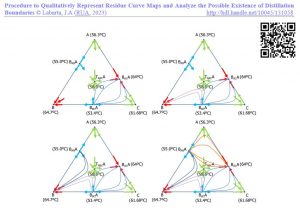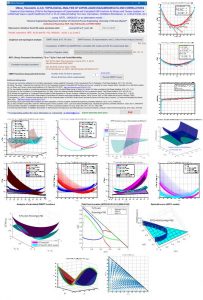The analysis of residue curve maps is essential to know the VLE behavior of a ternary mixture, the possible existence of distillation boundaries and therefore different distillation regions in the ternary composition diagram, and the corresponding areas where the different distillation products are located. All this knowledge is necessary for the correct design of distillation column sequences especially when azeotropic distillation columns are included.
As a first step, it is possible to represent qualitative residue curve maps just by knowing the equilibrium temperature of all the characteristic points (nodes) of the ternary system, i.e. pure components, and binary and ternary azeotropes (if they exist). Here you can find a simple guide (RUA, 2023): http://hdl.handle.net/10045/131058.
More information about distillation boundaries and residue curves maps definition and calculation:
- Labarta, J.A.; Olaya, M.M.; Marcilla, A. GMcal_TieLinesVL: Graphical User Interface (GUI) for the Topological Analysis of Experimental and Calculated GM Functions for Binary and Ternary (isobaric or isothermal) Vapor-Liquid Equilibrium (VLE) data (including Tie-Lines, Derivatives, Distillation Boundaries, LL Critical Points Location, etc.). Institutional Repository of the University of Alicante (RUA). 2022. Publicly available online at: http://hdl.handle.net/10045/122857.
- Labarta, J.A.; Serrano, M.D.; Velasco, R.; Olaya, M.M.; Marcilla, A. Approximate Calculation of Distillation Boundaries for Ternary Azeotropic Systems. Eng. Chem. Res. 2011, 50 (12), 7462-7466. DOI: http://dx.doi.org/10.1021/ie101873.
- Labarta, J.A.; Caballero, J.A.; Marcilla, A. Numerical Determination of Distillation Boundaries for Multicomponent Homogeneous and Heterogeneous Azeotropic Systems. Computer Aided Chemical Engineering. 2010, 28(C), 643-648. DOI: http://dx.doi.org/10.1016/S1570-7946(10)28108-7. Institutional Repository (RUA): http://hdl.handle.net/10045/14202.
- Gómez, A.; Ruiz, F.; Marcilla, A.; Labarta, J.A.; Menargues, S. Diseño de la separación de mezclas ternarias (I). Conceptos gráficos del equilibrio entre fases. Ingeniería Química. 2001, 377, 219-229. Institutional Repository (RUA): http://hdl.handle.net/10045/24715.
- Gómez, A.; Ruiz, F.; Marcilla, A.; Labarta, J.A.; Menargues, S. Diseño de la separación de mezclas ternarias (II). Aplicación de conceptos gráficos a la separación de mezclas azeotrópicas. Ingeniería Química. 2001, 379, 253-262. Institutional Repository (RUA): http://hdl.handle.net/10045/24716.


